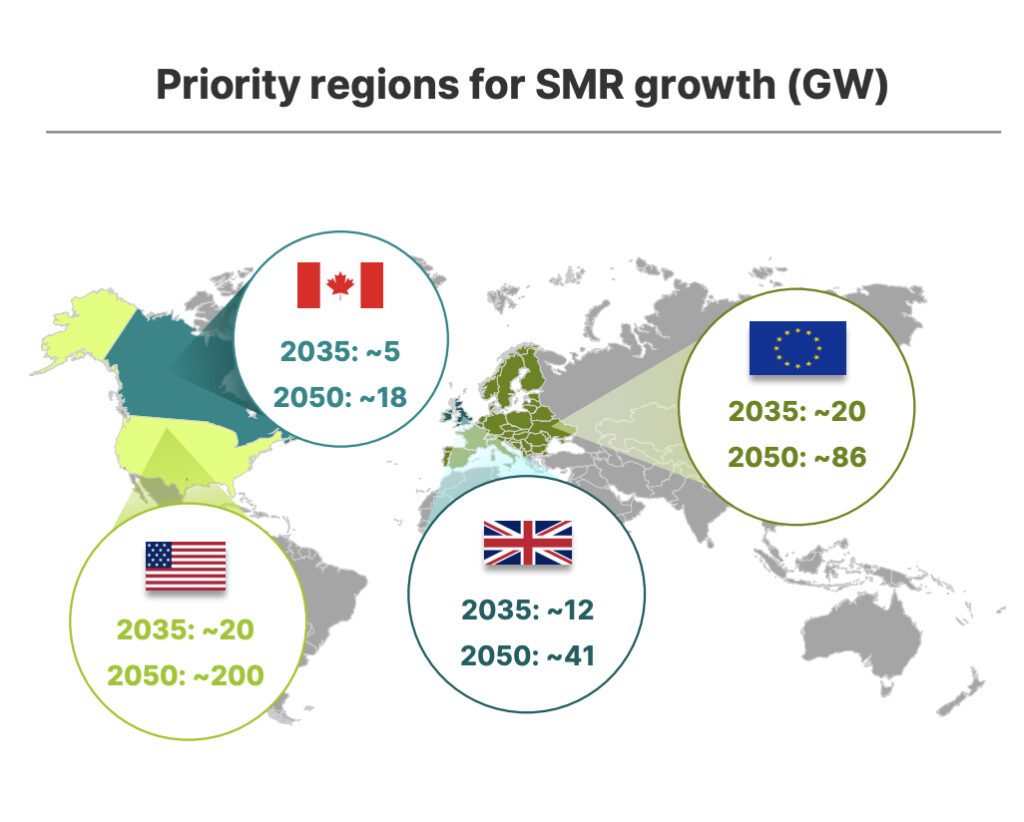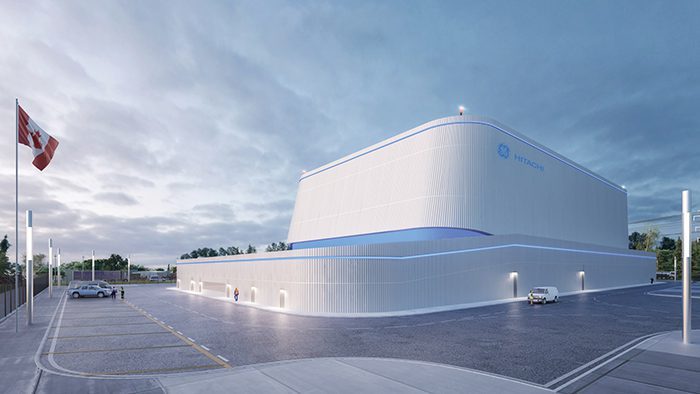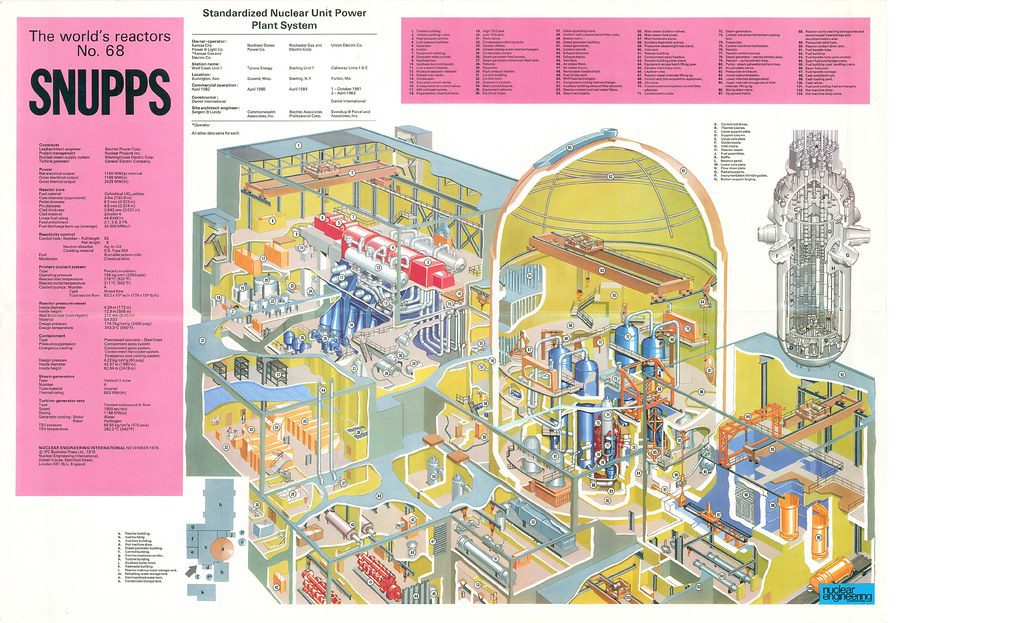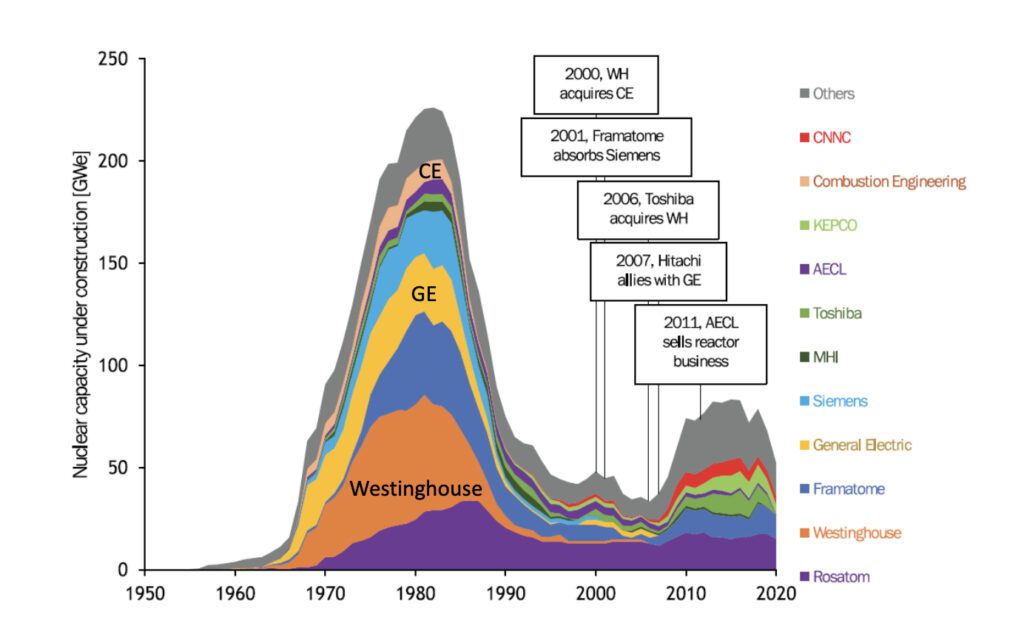Nuclear Supply Chain for the BWRX-300 SMR Takes Shape
GE Hitachi Nuclear Energy (GEH) is forming a group of qualified supply chain companies to help ensure the deployment of its BWRX-300 small nuclear modular reactor (SMR). The move comes as power companies vie for components amidst a supply chain strain that has led some sectors to delay critical infrastructure projects and ramped up competition for scarce resources and long-lead components.
GEH on April 29 said the purpose of the supplier group “is to help ensure a reliable, cost-effective, and innovative process for the manufacture and commercialization of the BWRX-300. “Supplier collaboration is expected to help build capacity and support cost reduction, project schedule goals, and scalability as we deploy the BWRX-300 globally,” noted GEH president and CEO Jay Wileman on Monday.
Suppliers Will Meet Pre-Defined Criteria
GEH’s supplier group will comprise suppliers “who meet pre-defined criteria, customer requirements and demonstrate a willingness to invest in BWRX-300 supply chain capabilities are eligible for selection to the group,” the company added.
The first company to join the group is BWXT Canada, a subsidiary of Lynchburg, Virginia–based manufacturing and engineering firm BWXT Technologies. On April 19, BWXT announced a notable C$80 million ($58.4 million) investment to expand a manufacturing plant in Cambridge, Ontario, where it designs and manufactures large and heavy nuclear components. The expansion will support “ongoing and anticipated customers’ investments in [SMRs], traditional large-scale nuclear and advanced reactors, in Canada and around the world,” it noted. The investment is expected to “increase capacity significantly, improve productivity, and create more than 200 long-term jobs for skilled workers, engineers, and support staff in the area,” the firm said.
On Monday, John MacQuarrie, president of BWXT Commercial Operations, noted the anticipated global demand for nuclear power was a “significant factor” in BWXT’s decision to expand the manufacturing facility. “Our plans to increase the site’s manufacturing capacity by 50% for large components and to invest in advanced manufacturing equipment over the next few years will further position our business to help deliver the BWRX-300 and other reactor technologies for our customers around the world,” he added.
Another Big Step for the BWRX-300
The announcement marks a significant strategic step for GE Hitachi, a joint venture between GE Vernova and Hitachi (where GE Vernova owns the majority interest outside of service operations in Japan), signaling its commitment to the future of the BWRX-300 project.
The BWRX-300, GEH’s flagship SMR, is the 10th evolution of GE’s boiling water reactor (BWR) design. The design is based on the Gen III+ 1,520-MW ESBWR, which the Nuclear Regulatory Commission (NRC) certified in 2014.
In March, GE Vernova suggested demand for advanced nuclear plants could be evenly split between large reactors and SMRs, with “each accounting for around 375 GW by 2050.” Demand for large reactors will be led by emerging markets, led by China and India, while North America and Europe will “strongly favor SMRs,” it said. “SMR’s value proposition is based on lower capital at-risk, smaller footprint, and greater modularity,” it said.

So far, GEH is set to build its first 300-MW BWRX-300 reactor at Ontario Power Generation’s (OPG’s) Darlington New Nuclear Project (DNNP) site east of Darlington Station in Bowmanville, Ontario, anticipating it would be ready for commercial operation in 2029. Several other prospects are in the pipeline, including three additional SMRs at Darlington, two potential units in Saskatchewan, and 24 BWRX-300 SMRs at six sites in Poland, for which the Polish government has announced decisions in principle.
OPG, the Tennessee Valley Authority (TVA), and Polish firm Synthos Green Energy (SGE) in March 2023 kicked off efforts to collaborate on a standard design for the BWRX-300 to speed up the technology’s regulatory acceptance and spur future deployments. Under the collaboration, the companies will also develop a detailed design for key BWRX-300 power plant components, such as reactor pressure vessels and internals. In addition, the three power companies are slated to form a “Design Center Working Group” whose purpose will be “ensuring the standard design is deployable in multiple jurisdictions.”
A month before, in February 2023, GEH unveiled a partnership with Canadian firms OPG, AtkinsRéalis, and Aecon to support the construction of the first BWRX-300 at Darlington. The companies’ alliance agreement—the first of its kind for a grid-scale SMR in North America—represented a deliberate effort to tackle construction complexities, potential delays, and cost overruns associated with the new build.
Earlier this year, the UK granted GEH £33.6 million ($42.7 million) under its Future Nuclear Enabling Fund, a program aimed at boosting nuclear technology maturation to further develop the BWRX-300 in the UK. GEH notes it has been developing a UK supply chain, which includes a memorandum of understanding with Sheffield Forgemasters for a potential supply agreement for UK-sourced steel forgings in support of the deployment of BWRX-300 SMRs.
GEH’s BWRX-300, meanwhile, will use GNF2, a proven nuclear fuel assembly. OPG in November 2023 unveiled four contracts to ensure a fuel supply for the first SMR at Darlington. Contractors include Cameco, which will supply natural uranium hexafluoride (UF6) from a conversion facility in Port Hope, Ontario. Urenco USA will provide uranium enrichment services from its operations in Eunice, New Mexico, while French nuclear fuel firm Orano will provide additional Enriched Uranium Product (EUP) from their operations in France. GNF, GE Vernova’s nuclear fuel arm, will provide fuel fabrication and related technical services and fuel assemblies.
According to GE Vernova, these efforts are part of a strategic effort to deploy the BWRX-300 using a “design-to-cost approach.” Specifically, “the BWRX-300 leverages a unique combination of existing fuel, plant simplifications, proven components, and a design based on an NRC-certified reactor design,” the company noted.

Mass SMR Deployment Relies Heavily on an Adequate Nuclear Supply Chain
The effort is significant given that experts agree achieving a mass scale-up of SMR deployment will heavily rely on streamlining the supply chain. “The scale of SMR deployment will depend on the success in delivering first-of-a-kind projects and in the industrialization and modularization of manufacturing and supply chain activities,” the OECD Nuclear Energy Agency (NEA) recently said in materials associated with a nuclear supply chain workshop it hosted alongside the World Nuclear Association in March.
A key issue facing the nuclear industry relates to a declining number of nuclear-grade suppliers and a loss of skills in some regions, NEA noted. Supply chain development, particularly for advanced nuclear, will require a strong emphasis on quality delivery, which will require strengthened management of advanced manufacturing and commercial-grade procurement. It will also require a keen awareness of continued risks “associated with counterfeit and fraudulent activities and potential methods to mitigate risks in a constantly changing environment,” NEA said.

In the U.S., the Department of Energy (DOE) is pursuing several notable actions to bolster a supply chain to support the existing nuclear fleet and support a build-out for advanced nuclear.
The agency notes that while the U.S. led the first global wave of construction from the 1960s to the 1980s, U.S. vendors have built few reactors domestically or globally during the second construction wave that begain in the early 2000s. That wave was dominated by Russia’s Rosatom, France’s Framatome, Japan’s Toshiba, and South Korea’s Korea Electric Power Corp. The majority of new reactors over the past decade have been built in China. The DOE suggests much work remains on all fronts. For example, “The U.S. O&M supply chain has atrophied as U.S. reactor exports have declined,” the DOE acknowledges, noting: “The U.S. O&M supply chain would benefit both from growth in the domestic nuclear fleet and from growth in U.S. reactors exports.”

In a detailed 2022 report, the agency pointed to several gaps including as they relate to labor, critical minerals, fuel, resource extraction, material and component manufacturing, and construction. Over the long term, the U.S. may need to address even more supply issues related to nuclear waste disposal and the simultaneous decommissioning of many U.S. nuclear plants, it has said.
The DOE has so far taken concerted steps to address the nuclear fuel cycle. As of March 22, it had closed requests for proposals (RFPs) for the purchase of enriched and deconverted high-assay low enriched-uranium (HALEU), crucial parts of the advanced nuclear fuel supply chain. The measure is furnished by $700 million allocated by the 2022 Inflation Reduction Act (IRA) to support activities under the HALEU Availability Program (which Congress established in the Energy Act of 2020).
The DOE on April 19 also noted that Centrus Energy’s American Centrifuge Project has now enriched more than 100 kilograms (kg) of HALEU at its Piketon, Ohio, plant and was working toward an additional 900 kilograms. In addition, the DOE said the U.S. is “working hand-in-glove” with the UK, France, Japan, and Canada—the “Sapporo 5”—to establish a “secure and resilient” global nuclear fuel supply chain to ensure continued operation and support the growth of nuclear energy deployment around the world free of Russian influence.
—Sonal Patel is a POWER senior editor (@sonalcpatel, @POWERmagazine).
Updated (April 30): Adds details about BWRX-300 fuel and potential suppliers.